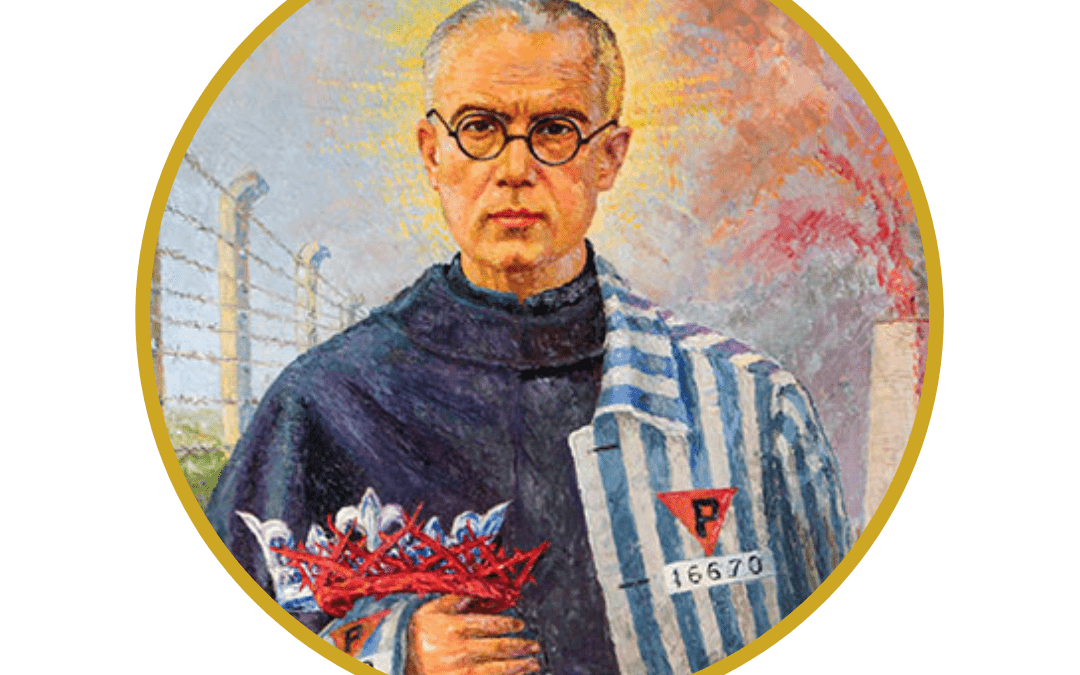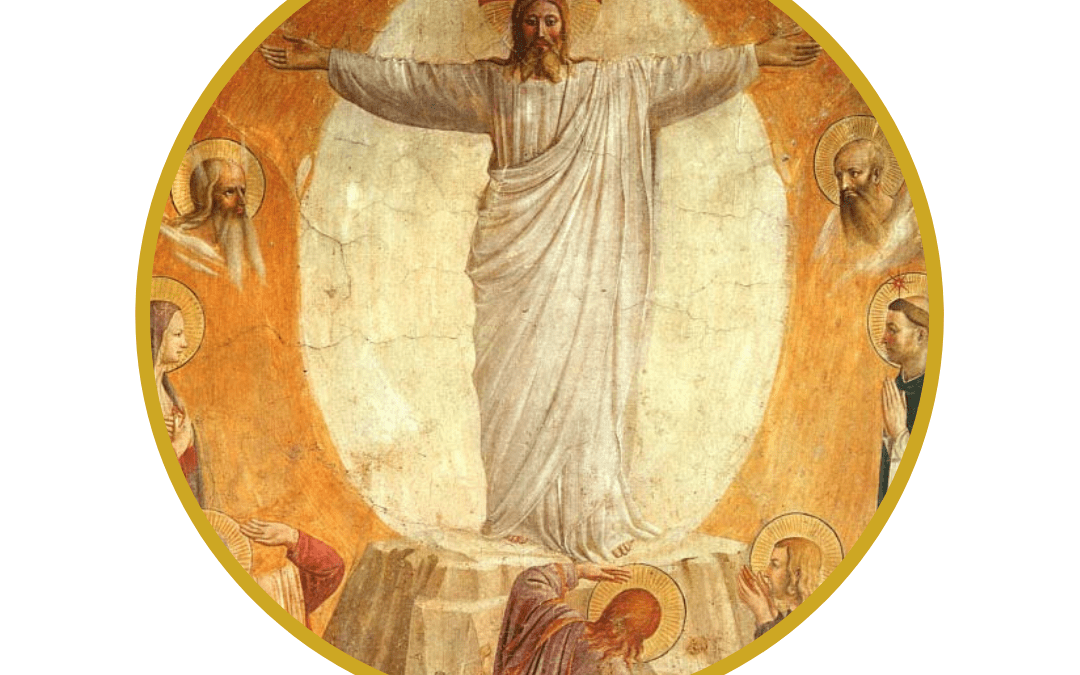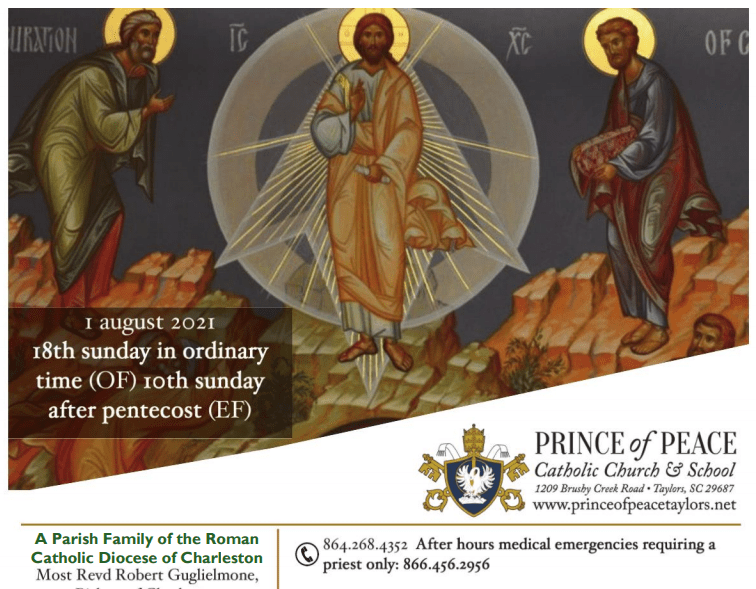
by popadmin | Aug 2, 2021 | CIC Saint Writeups
Saint Maximilian was born Raymond Kolbe in Poland in 1894. As a youth, he had a vision from the Blessed Mother. He described it best himself: “That night, I asked the Mother of God what was to become of me. Then she came to me holding two crowns, one white, the other red. She asked me if I was willing to accept either of these crowns. The white one meant that I should persevere in purity, and the red that I should become a martyr. I said that I would accept them both.” In 1910, he entered the novitiate of Conventual Franciscan Order and was given the name Maximilian. He was sent to study in Rome where he was ordained a priest in 1918. After returning to Poland in 1920, he wrote: “I must be a saint, the greatest saint possible. Remember that you are the absolute, unconditional, unlimited, irrevocable property of the Immaculate… My life, my death and my eternity are yours, O Immaculate. Do with me whatever you wish.” Back in Poland, Father Maximilian organized his Militia of the Immaculate Virgin Mary – a movement of Marian consecration. In 1922, he published the magazine, “Knight of the Immaculate” to promote devotion to Mary. In 1927, he built a town called the “Town of the Immaculate,” outside of Warsaw. There he trained ‘apostles of Mary’. By 1939, the City had expanded from 18 friars to 650, making it the world’s largest Catholic religious house. To better “win the world for the Immaculata,” the friars utilized modern printing techniques. They published countless catechetical and devotional tracts, a daily newspaper and a monthly magazine with a circulation of over one million. Maximilian started a shortwave radio station –he was a true “apostle of the mass media.” He was also a ground-breaking theologian. His insights into the Immaculate Conception developed understanding of Mary as “Mediatrix” of all graces and as “Advocate” for God’s people. In 1941, the Nazis imprisoned Father Maximilian in Auschwitz. In July, it was reported to the camp commander that a prisoner had escaped. In order to set an example, they selected ten men for the starvation bunker. When a man near him was chosen, a man who cried in protest because he had a family, Maximilian bravely stepped forward and said “Let me take the place of this man. I am a Catholic priest.” Maximilian was taken to endure an excruciatingly slow death. On August 14, 1941, the vigil of the Assumption of the Blessed Virgin Mary, Father Maximilian’s two-week ordeal in the starvation bunker was brought to an end by an injection of carbolic acid. Of the ten victims, he was the last to die. “Hail Mary!” was the last prayer on the lips of Father Maximilian, as he offered his arm to the person injecting the acid. In 1982, Saint JP II canonized Maximilian Kolbe as a “martyr of charity.” Saint Maximilian Kolbe is considered a patron of journalists, families, prisoners, the pro-life movement and the chemically addicted.
“Greater love has no man than this, that a man lay down his life for his friends” (John 15:12)
Ideas for celebrating this feast at home:
- In honor of this Polish saint, make Polish recipes for dinner. Ideas: Kielbasa Stew or Polish Kielbasa and Pierogies Sheet Pan Meal. For dessert, Polish Lemon Babka or Polish Cream Cheese Cookies (“Kolaczki”). OR, make two cakes, one red and one white, to symbolize the two crowns that Maximilian accepted.
- Watch the movie Maximilian: Saint of Auschwitz available on FORMED (ages 10+).
- For younger children, watch the Lukas Storyteller video Saint Maximilian Kolbe, also on FORMED.
- Children may enjoy crafting homemade red and white “crowns” (use construction paper and stickers or glitter, etc!) to wear at dinner and discuss what it means to live out the virtue of purity and to be called to martyrdom. Encourage each other to always be open to God’s calling in our lives.
- Offer a Mass, say a rosary, pray for those who suffer in the world today from man’s inhumanity. Pray for an end to abortion, our nation’s own holocaust. Be a living witness to the culture of life.
(sources: catholicculture.org; saintmaxmiliankolbe.com; showerofrosesblog.com)

by popadmin | Aug 1, 2021 | CIC Saint Writeups
6 August: Feast of the Transfiguration of the Lord. The Transfiguration is one of the major events in the earthly life of Jesus. The gospels tell the story of Jesus bringing Saint Peter and the two sons of Zebedee, Sts. James and John, up to the top of a high mountain to pray (tradition holds that it was Mount Tabor). This would have been about a year before Our Lord’s passion. While he was praying, Jesus’ appearance changed and his clothing became dazzling white: “His face shone like the sun, and his garments became white as light” (Mt 17:2). Next, Moses and Elijah appeared in glory and spoke with Jesus of things that were to come. The disciples were amazed and overwhelmed. Unsure what to do, St. Peter offered to put up tents for Jesus and his friends. Although they had been with Jesus for three years, the disciples still did not really understand who He was. Then, a cloud overshadowed them. They became frightened and heard a voice from Heaven saying: “This is my beloved Son, with whom I am well pleased; listen to him.” (Mt 17:5). After Moses and Elijah disappeared, Jesus instructed the disciples not to tell anyone about this “until the Son of man has been raised from the dead” (Mt 17:9). This event, called the Transfiguration, is significant in the Christian faith. Saint Thomas Aquinas called it “the greatest miracle” because it revealed the divinity of Christ before his passion and death. In the Transfiguration, Christ enjoyed for a short while that glorified state which was to be permanently His after the Resurrection. The splendor of His inward Divinity and of the Beatific Vision of His soul overflowed on His body, and permeated His garments so that Christ stood before Peter, James, and John in a snow-white brightness. This feast day became widespread in the West in the 11th century and was introduced into the Roman calendar in 1457 to commemorate the victory over Islam in Belgrade. Before that, the Transfiguration of the Lord was celebrated in the Syrian, Byzantine, and Coptic rites. The Transfiguration foretells the glory of the Lord as God, and His Ascension into heaven. It anticipates the glory of heaven, where we shall see God face to face, in all of His dazzling glory.
Ideas for celebrating this feast day at home:
- Pray a decade of the Luminous mysteries together as a family—the Transfiguration, of course!
- In the Scriptures, mountains are often portrayed as sacred places where humans meet God. (Think of Moses on Mt. Sinai and Elijah on Mt. Horeb.) If you can, take a mountain hike today and spend some time in quiet prayer and reflection.
- Celebrate this feast day with all things WHITE! Wear white clothing; set the dinner table with a white tablecloth and white candles; cook and eat lots of white foods to recall how Jesus’ face “shone like the sun and his clothes became white as light” (Mt. 17:2).
- Ideas: egg white omelets and biscuits for breakfast; fettuccine alfredo or white fish with mashed potatoes or white rice for dinner. Dessert could be meringue cookies; Mexican wedding cakes; or angel food cake with vanilla ice cream or homemade whipped cream. (Heavy cream is ‘transformed’ when you whip it up with a bit of sugar. This is a fun hands-on activity to do with children to bring to mind the Transfiguration!) OR, simply ‘transform’ leftover food into a new dinner to celebrate this transformative feast day.
- With tradition holding that the Pope presses ripe grapes into the chalice at Mass or uses new wine on this feast, don’t forget to enjoy a bottle of sparkling grape juice or red wine at supper tonight! (The symbolism here is the transformation: fruit develops from bud, to flower, to ripened fruit which is a natural transfiguration. Then, the grapes continue to be transformed from fruit, to juice, to wine, and then sacramentally, to the Blood of Christ received in the Eucharist.)
- View some paintings of the Transfiguration here.
- Here are some Transfiguration worksheets for kids to enjoy:
- Transfiguration maze
- Transfiguration word search and word jumble
- Transfiguration coloring pages

by popadmin | Aug 1, 2021 | Bulletin
Click to read this week’s bulletin: 1 August 2021



Recent Comments